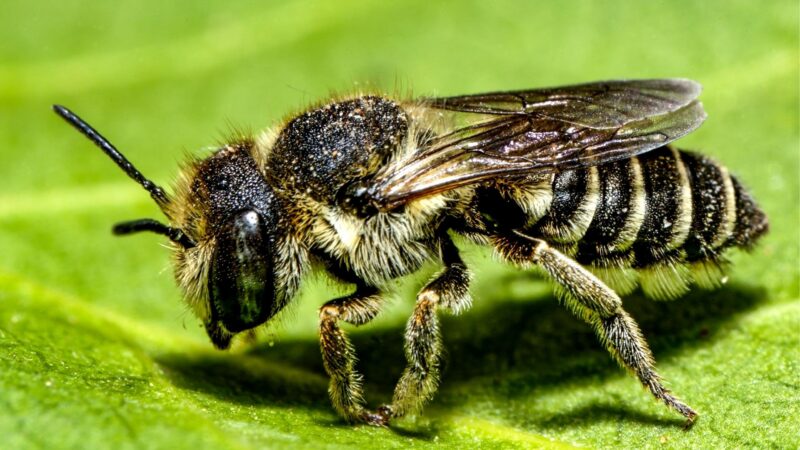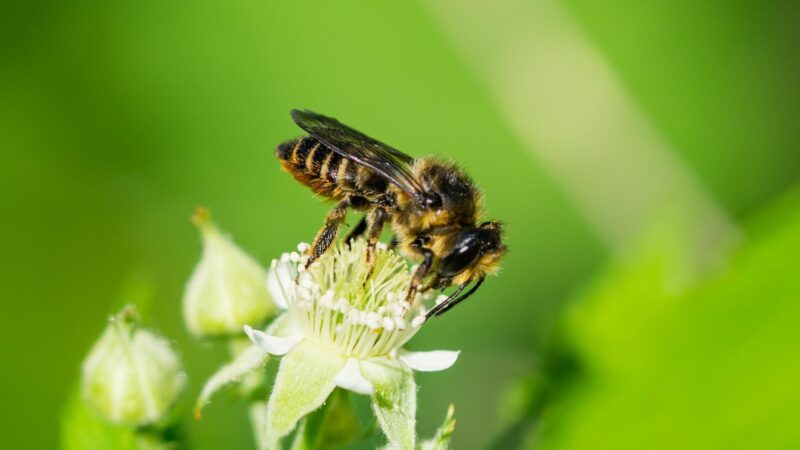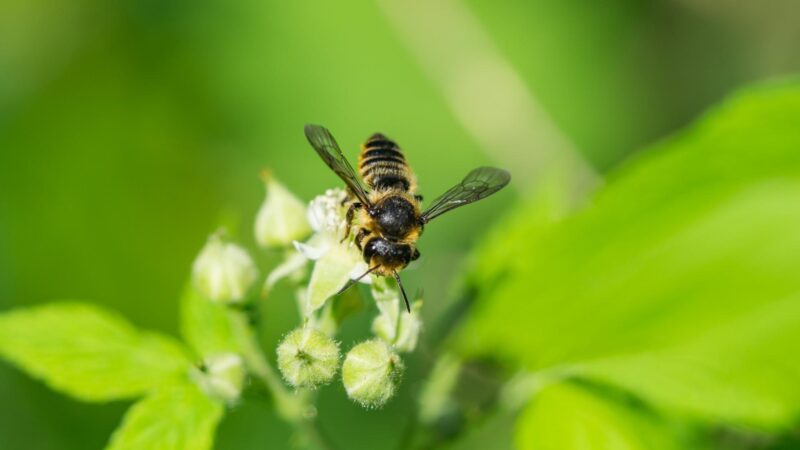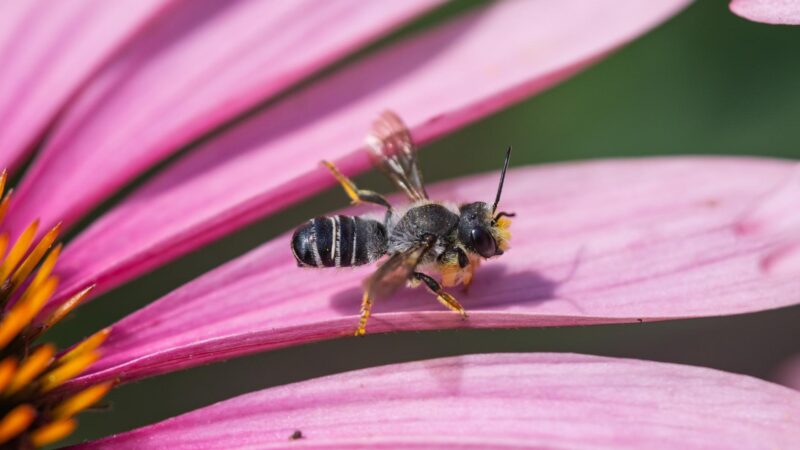Leafcutting bees are present around the world and they’re common in the United States.
Their presence is beneficial as they’re pollinators of fruits, vegetables, crops, wildflowers, and even those that are difficult to pollinate, such as apples, alfalfa, and legumes.
Just like honey bees, some of the species of leafcutter bees are made into commercial pollinators. Anyhow, do they cut leaves as their name suggests?
What is a leafcutter bee? This bee is a pollinator that does cut leaves to take out circular pieces within the sizes of .25” and .50”. These pieces are collected to build a cigar-like nest composed of several cells. Every cell contains pollen and one egg. Leafcutter bees usually put their nest in a hole, wood, pithy plants, or plant stem.
Leafcutter bees usually choose to cut the broad leaves of deciduous plants. They also use resin and petals to put up a nest.
In addition, they like to cut circles on the leaves of azaleas, ash, bougainvillea, redbud, roses, and other plants with smooth leaves.
Apart from being important pollinators, do leafcutter bees also cause problems like ruining the aesthetics of these plants? Read on to learn more.
Table of Contents
What Do Leafcutter Bees Look Like?

Most leafcutter bees are of medium size, and they can be compared to honey bees but darker with gray bands around their abdomen. Their black, stout bodies range from 5 mm to 24 mm.
They have hairs that they use to carry pollen. These hairs are on the underside instead of their hind legs. When a leafcutter bee carries pollen, its abdomen’s underside has the color of light yellow or deep gold.
Scopa or pollen pocket can only be seen in females. This pocket is located on their lower abdomen and covered by hair. Females are larger and more pointed than males that have blunter abdomens and hairy faces.
About Leafcutter Bees

You’ll only get stung by a leafcutter bee when you hold it as it’s protective of its nest. Hence, they’re not as aggressive as honey bees. This occurrence is not alarming as the sting is just mild.
Their ability to cut leaves is for the construction of their nest, but it concerns some people. They’re solitary, and it means that they don’t build a colony.
In terms of reproduction, females can control the gender of the offspring as they can keep and use the male sperm any time she wants. She may know that males develop faster than female offspring.
Hence, the male is placed in a cell near the entrance. The female ones are in the deepest part of the nest.
Parenting is solely done by the female leafcutter bee. She does other tasks like digging and building the nest, as well as feeding the offspring. When a larva turns into an adult, it chews the cells ahead of them to get out of the nest.
But it doesn’t mean it eats its siblings that block its way. It waits for the others to be fully developed.
What Do Leafcutter Bees Eat?
Leafcutter bees eat nectar and pollen. On the other hand, they don’t eat the leaves that they cut. The larvae of this bee are fed by pollen that its mother collected.
Where Do Leafcutter Bees Live?
Leafcutter bees live in holes, soil, pithy plants, stems, and diverse cavities inside the snail’s shell and holes in a concrete wall or man-made objects.
Moreover, they prefer plants with leaves and petals that are not too stiff or thick. It’s easy for them to make holes in rotten wood but they can still do it on thick stems of rose and bamboo.
Are Leafcutter Bees Rare?
Leafcutter bees are not rare since they’re commonly found in the United States and other parts of the world.
How Many Eggs Do Leafcutter Bees Lay?
The female leafcutter bee can live up to two months and lay 30 to 45 eggs.
How Far Can Leafcutter Bee Fly?
A leafcutter bee can fly within a radius of 100 meters from its nest. This scope is about 6 acres. Moreover, it can travel as far as half a mile to 2 miles to find a place to settle.
An interesting result came out of a study on how flight rate affects the sex ratio of this bee’s offspring. When there’s an increase in flight distance, so as the number of sons.
It also means that the mother leafcutter bee utilizes fewer resources for both sons and daughters. The total number of offspring is lower than when she flies short distances.
Do Leafcutter Bees Make Honey?

Leafcutter bees don’t make honey as they only use it to nourish themselves for the flight when searching and preparing for their nest. It’s also the reason why they’re not so protective of their nest as they don’t store honey in it.
Do Leafcutter Bees Sting?

Leafcutter bees sting, but it’s milder compared to what honey bees or wasps can inflict.
How to Control Leafcutter Bees?
Don’t use insecticides as they prove to be ineffective in controlling leafcutter bees. The right method is by covering the plants with cheesecloth or loose netting. You have to prevent leaf injuries during the time that these bees are most active.
It’s also a way to limit the breeding areas so the population of these bees won’t increase. But detection can be difficult. You have to search rotting wood and sawdust that comes out of the hollowed opening of plant stems or excavated tunnels.
You will need to cover the exposed pith of the rose cane, so leafcutter bees can’t create a tunnel. Insert a thumbtack in it as there’s a pruned cane. Then add a small amount of white glue or sealing wax from UNIQOOO in the opening.
How to Get Rid of Leafcutter Bees?
Neem oil has the power to get rid of leafcutter bees since it can stop their normal development and larval development. You can spray it on their suspected habitat. As mentioned, insecticide is not effective.
How to Get Rid of a Leafcutter Bee Nest?
Getting rid of the leafcutter bee nest is a way of killing this insect. You can put a drop or two of wax, candle, white glue, or wooden dowel in the hollow opening of its nest.
The larva stays in the nest over the winter and comes out of it as an adult in spring. If you cover its nest, it can’t come out as an adult and reproduce.
What Plants Do Leafcutter Bees Feed On?
Leafcutter bees feed on landscaping plants like roses, redbud, and plant species that have thin, flat petals and leaves.
Why Do Leafcutter Bees Cut Leaves?
Leafcutter bees cut leaves to form cells in the tunnel that they’ve already created. The mixture of pollen and nectar is used as glue to align the leaves together.
These cells are made for the female bee to lay eggs on, and they’re usually half an inch long. Once the nest is done, it looks like a cigar due to its cylindrical form.
One nest can be a tube of four to eight inches long. A dozen or more cells can be found inside it. An egg is placed on every cell where development occurs until it turns into an adult leafcutter bee.
Do Leafcutter Bees Kill Plants?
In most cases, leafcutter bees only cause minor injury to the plants. But when a large population of these bees is concentrated in a certain area, there’s serious damage.
This would likely happen in rural plantings that are not given much attention. Luckily, they don’t eventually kill plants.
Summary
The importance of leafcutter bees as a pollinator to various plants is undeniable. They’re not harmful as they don’t sting like honey bees and wasps.
Thus, you won’t worry about it when seeing them in gardens, prairiqes, and fields covered with flowers. They only destroy the aesthetics of the plants that they feed on. Still, their role as a pollinator outweighs their negative side.